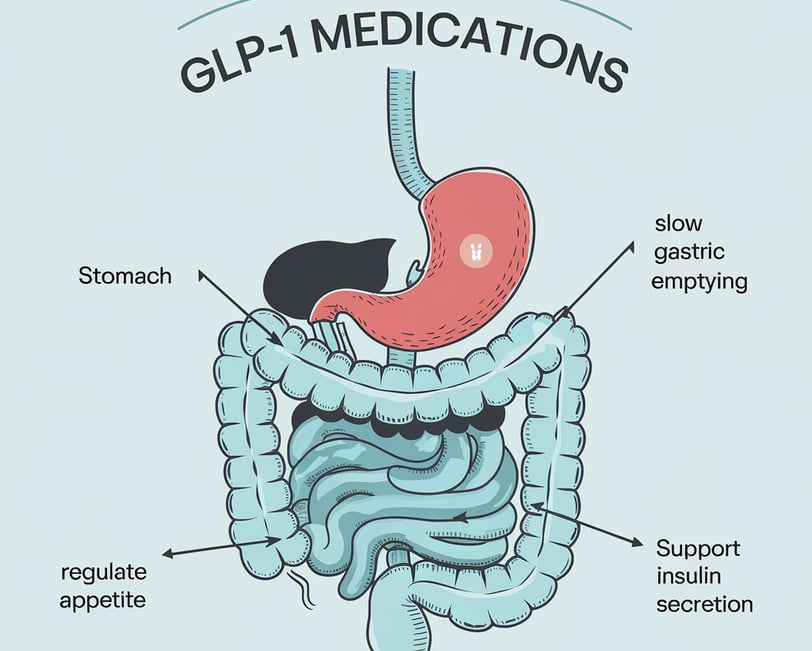Exclusive discounts on starter bundles today!
What Are GLP-1 Medications and How Do They Work?
GLP-1 medications, or glucagon-like peptide-1 receptor agonists, are a class of drugs that have revolutionized the treatment of type 2 diabetes and are now making waves as highly effective weight-loss therapies.
EXPERT INSIGHT & SCIENCE
5/8/20243 min read


GLP-1 medications, or glucagon-like peptide-1 receptor agonists, are a class of drugs that have revolutionised the treatment of type 2 diabetes and are now making waves as highly effective weight-loss therapies. First introduced in 2005, these medications mimic a naturally occurring hormone called GLP-1, which plays a crucial role in regulating blood sugar levels and appetite. In this article, we’ll explore the history, mechanisms and evolving uses of GLP-1 medications, as well as what the future holds for this exciting field.
The Origins: GLP-1 for Diabetes Treatment
The journey of GLP-1 medications began in the early 2000s when researchers discovered the potential of GLP-1 receptor agonists to help people with type 2 diabetes better manage their blood sugar levels. The first FDA-approved GLP-1 medication, exenatide (Byetta), was derived from a compound found in the saliva of the Gila monster lizard. Approved in 2005, exenatide and other first-generation GLP-1s worked by:
Stimulating Insulin Release: GLP-1 medications increase insulin secretion in response to elevated blood sugar levels.
Suppressing Glucagon: They reduce glucagon secretion, which prevents the liver from producing excessive glucose.
Slowing Gastric Emptying: By delaying how quickly food leaves the stomach, they help regulate post-meal blood sugar spikes.
While these effects significantly improved blood sugar control, early GLP-1 medications had limitations. They required frequent injections, often caused gastrointestinal side effects like nausea and their effectiveness was modest compared to newer treatments. Despite these challenges, first-generation GLP-1s paved the way for ongoing innovation.
The Weight Loss Revolution
As researchers studied GLP-1 medications, they noticed an intriguing side effect: significant weight loss in many patients. GLP-1 agonists reduce appetite and increase feelings of fullness by acting on the hypothalamus, the brain’s appetite-regulating centre. This discovery led to a paradigm shift in the use of GLP-1 medications.
Drugs like liraglutide (Saxenda) and semaglutide (Wegovy) were later approved specifically for weight loss in people with or without diabetes. These medications not only help patients shed pounds but also improve metabolic health by reducing risks associated with obesity, such as hypertension, cardiovascular disease and certain cancers.
The popularity of GLP-1 medications for weight loss has soared, with demand outstripping supply in many markets. Patients and healthcare providers alike view these drugs as game-changers, particularly for individuals struggling to achieve sustainable weight loss through diet and exercise alone.
What Sets GLP-1s Apart for Weight Loss?
GLP-1 receptor agonists target multiple aspects of appetite and metabolism:
Reduced Hunger: They suppress hunger signals, helping patients eat less without feeling deprived.
Increased Satiety: By enhancing the sensation of fullness, these medications make smaller meals satisfying.
Improved Energy Regulation: GLP-1s shift the body’s energy balance, promoting fat loss over muscle loss.
Unlike earlier weight-loss drugs, GLP-1s offer a relatively favorable safety profile and are less likely to cause serious side effects. However, common issues like nausea and vomiting remain challenges for some patients.
The Future: Newer and Better Peptides
The field of GLP-1 medications continues to evolve rapidly. Pharmaceutical companies are investing heavily in developing next-generation GLP-1 agonists and other peptide-based therapies. Eli Lilly, a leader in this space, has over 100 clinical trials underway exploring innovative ways to enhance the efficacy and convenience of these medications.
Some of the exciting advancements include:
Dual and Triple Agonists: Combining GLP-1 receptor activity with other mechanisms, such as GIP (glucose-dependent insulinotropic polypeptide) and glucagon receptor agonism, to deliver even greater metabolic benefits.
Oral Formulations: Eliminating the need for injections to improve patient adherence.
Longer-Lasting Drugs: Reducing dosing frequency from weekly to monthly or beyond.
Targeted Therapies: Creating personalised medications tailored to individual genetic or metabolic profiles.
These innovations promise to expand the reach of GLP-1 therapies, making them more accessible, effective and tolerable for patients worldwide.
GLP-1 medications have come a long way since their introduction in 2005. Initially developed to help manage type 2 diabetes, these drugs have found a second life as powerful weight-loss therapies. With ongoing research and development, the potential of GLP-1 receptor agonists appears limitless, offering hope to millions of people struggling with metabolic disorders.